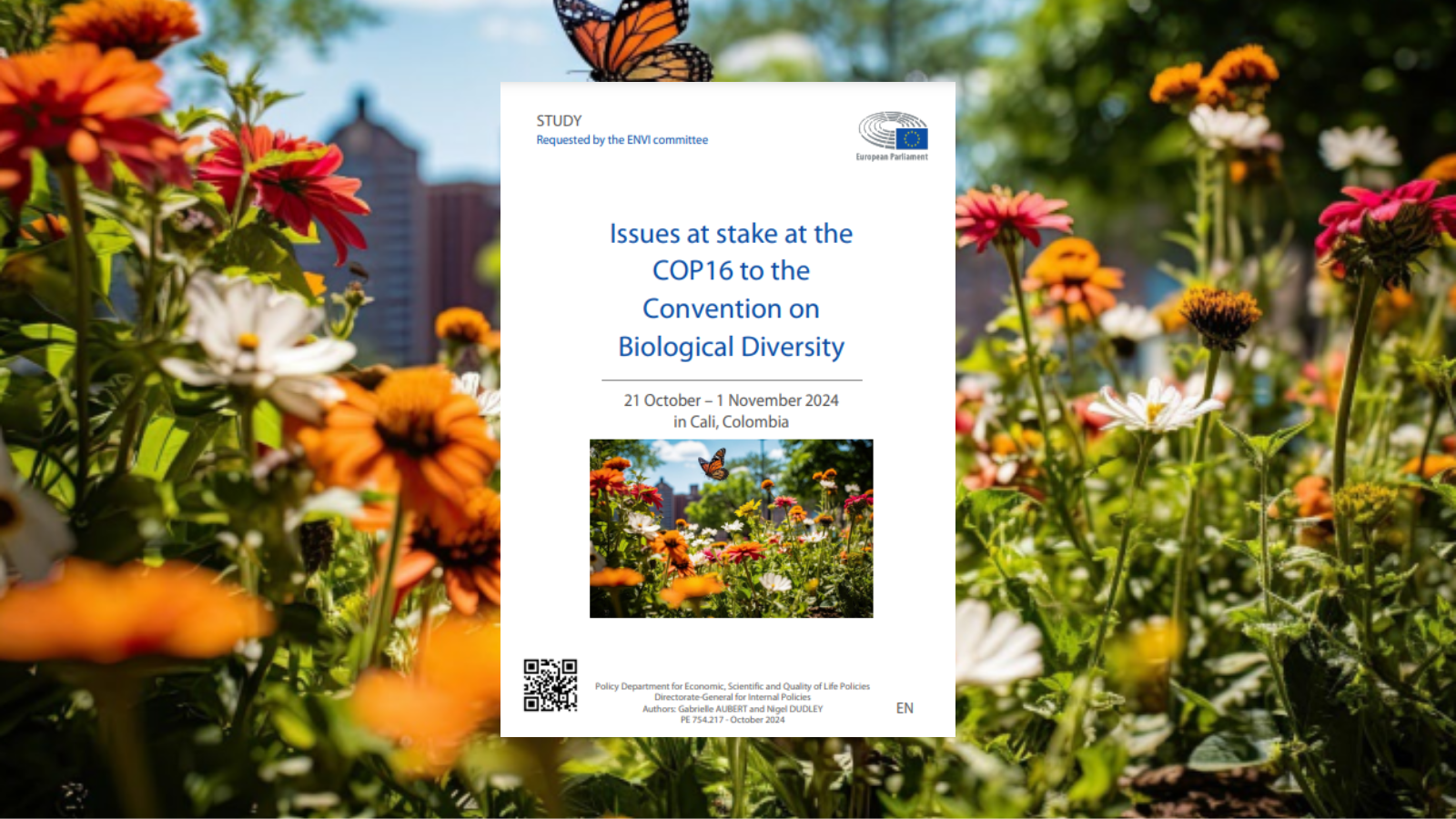AUTHORS: Gabrielle Aubert, Nigel Dudley (Equilibrium Research). This study was requested by the European Parliament’s committee on Environment, Public Health and Food Safety (ENVI) and is accessible here.
As governments gear up for COP16 of the Convention on Biological Diversity (CBD), this study highlights critical issues at stake, focusing on implementation mechanisms for the Kunming-Montreal Global Biodiversity Framework (GBF) and progress made so far in implementation.
The Kunming-Montreal Global Biodiversity Framework
Adopted in December 2022 during COP15, the Kunming-Montreal Global Biodiversity Framework (GBF) is a landmark agreement for global biodiversity conservation, setting a vision for 2050 of a world living in harmony with nature (1). It establishes four goals and 23 ambitious targets for biodiversity conservation. It faces the challenge of avoiding the failures of its predecessor, the Aichi targets (2), amidst an ever-so-urgent biodiversity crisis, as highlighted by WWF’s Living Planet report which shows a 73% decline in wildlife populations between 1970 and 2020 (3). Unlike the Aichi targets, the GBF is built on a robust monitoring framework and mechanisms for reporting and reviewing progress, designed to surpass its shortcomings.
As a voluntary agreement, the GBF relies on the commitment and ambition of its 193 signatories. COP16, held from 21 October to 1 November 2024 in Cali, Colombia, will assess progress in implementation and finalise mechanisms for effective implementation.
Key issues at stake
COP16 has been referenced to as the ‘Implementation COP’, as negotiations will focus on finalising and agreeing on mechanisms for implementation of the GBF. Colombia, as COP President, has identified three key priorities to be addressed at COP16 (4):
- Translating GBF targets into ambitious and aligned national commitments. Parties are expected to have submitted their National Biodiversity Strategies and Action Plans (NBSAPs) and national targets and to demonstrate their alignment with the GBF. At COP16, a global analysis of progress will take place, based on these submissions. Only about 25 countries, including the EU and nine of its Member States, have submitted revised NBSAPs as of 10 October 2024 (5).
- Finalising implementation mechanisms. COP16 will also focus on finalising a comprehensive monitoring framework, the mechanism for planning, monitoring, reporting and reviewing and a financial mechanism. A major point of contention remains the financial structure. While the Global Biodiversity Framework Fund (GBFF) was established as part of the Global Environment Facility (GEF) with US$245 million in contributions so far, countries of the Global South, such as the African group and Brazil, criticise its legitimacy and capacity to channel enough funds. They argue for the creation of a new fund at COP16, while the EU and Global North countries advocate for the existing GBFF structure.
- Adoption of a multilateral agreement on the fair and equitable sharing of benefits from the use of digital sequence information (DSI) on genetic resources, including a global fund. Parties are expected to reach an agreement on a system which would ensure that benefits from the use of DSI, which refer to dematerialised genetic resources, are shared with the countries of origin and that financial gains from DSI support the GBF targets.
In addition to the COP16 presidency’s priorities, the European Commission has identified two further priorities:
- Strengthening the connection between climate and biodiversity agendas. Given the upcoming COPs of the UN Framework Convention on Climate Change (UNFCCC) and the UN Convention to Combat Desertification (UNCCD) quickly after COP16, there is a need for stronger integration between climate and biodiversity efforts, particularly in relation to GBF Targets 8 and 11.
- Operationalising work on biodiversity mainstreaming. The Commission seeks to advance the mainstreaming of biodiversity across sectors like agriculture, fisheries, forestry, energy and transport, in an effort to push implementation of Target 14 at COP16. It may receive support from China, which has identified biodiversity mainstreaming as a key priority in its NBSAP (6).
Progress on GBF implementation
While it is still early to assess the overall progress of GBF implementation, some significant developments – not exhaustive – are worth noting.
- Several countries have committed to protecting 30% of their land and sea by 2030 (Target 3), with some enshrining it in national legislation. Moreover, the High Seas Treaty, signed in September 2023, provides a legal framework for designating Marine Protected Areas (MPAs) in areas beyond national jurisdiction and is a crucial milestone in achieving GBF Target 3. The EU plans to ratify it along with its 27 Member States before the UN Ocean Conference in June 2025 (7).
- The adoption of the EU Nature Restoration Law in July 2024 is a key step in achieving the GBF’s restoration target (Target 2), with important benefits climate resilience (Targets 8 and 11) and sustainable management of biodiversity in agriculture, fisheries and forestry (Target 10).
- Progress was also made in mobilising financial resources (Target 19). The $20 billion tracker, led by NGOs, finds that commitments for biodiversity finance from governments, philanthropists, corporations and investors and multi-donor funding mechanisms and initiatives have reached US$8 billion annually, representing 40% of the US$20 billion international finance target (8).
Despite these advancements, progress must be made on implementing all 23 GBF targets. Other targets such as those related to pollution (Target 7), sustainable species and biodiversity management (Targets 4, 5, 9 and 10), climate and ecosystem resilience (Targets 8 and 11) and biodiversity mainstreaming (Target 14) have received less focus and action. The finalisation of indicators in relation to these targets is therefore a significant step for implementing the GBF.
Looking ahead
COP16 is a crucial milestone in the implementation of the GBF. While COP15 laid the groundwork, COP16 will focus on operationalising and finalising these mechanisms and analysing the progress of NBSAPs and national targets. The first and second global reviews of progress under the GBF will take place in 2026 and 2030, during COP17 and COP19, respectively.
_________________________________
(1) Conference of the Parties to the Convention on Biological Diversity, Kunming-Montreal Global Biodiversity Framework, Fifteenth meeting Part II, Montreal, Canada, 19 December 2022, CBD/COP/DEC/15/4. Available at: https://www.cbd.int/doc/decisions/cop-15/cop-15-dec-04-en.pdf/.
(2) Secretariat of the Convention on Biological Diversity, 2011, Strategic Plan for Biodiversity 2011-2020, including Aichi Biodiversity Targets. Available at: https://www.cbd.int/sp.
(3) WWF, Living Planet Report 2024. Available at: https://livingplanet.panda.org/.
(4) Secretariat of the CBD, On the road to COP16 in Cali: three priority areas for action, February 2024. Available at: https://www.cbd.int/article/colombia-host-city-cali-cop16.
(5) Secretariat of the CBD, National Biodiversity Strategies and Action Plans (NBSAPs). Available at: https://www.cbd.int/nbsap.
(6) Sino-German Environmental Partnership, Biodiversity: China’s new NBSAP to implement the post-2020 GBF, March 2024. Available at: https://environmental-partnership.org/news/biodiversity-chinas-new-nbsap-to-implement-the-post-2020-gbf/.
(7) European Commission, 2024, Remarks by Commissioner Hoekstra at the High Ambition for the High Seas UNGA Event, 24 September, New York. Available at: https://ec.europa.eu/commission/presscorner/detail/en/speech_24_4843.
(8) Nature Finance Info, $20 Billion Tracker. Available at: https://www.naturefinance.info/



